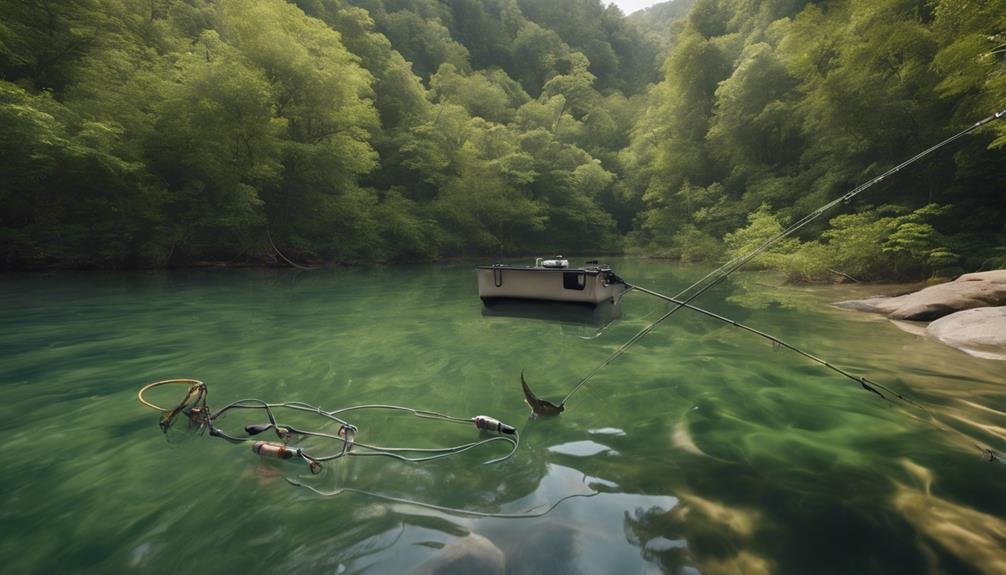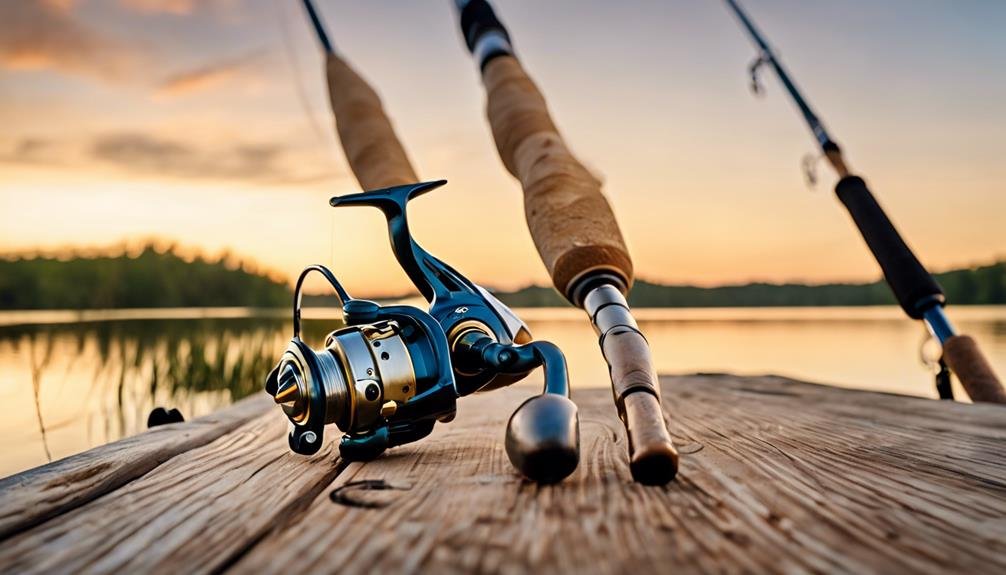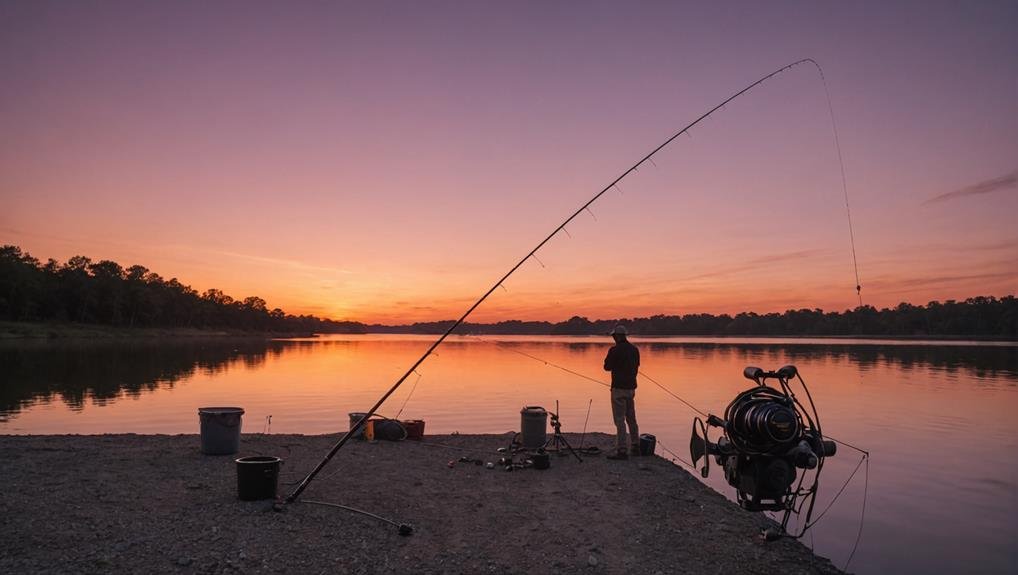When setting up for a successful catfish outing, the type of rig you choose is essential. You’ll find that drift rigs, slip float rigs, and slip rigs offer unique advantages in different conditions. Whether adjusting float depth or using poly balls for bait suspension, these rigs enhance bait presentation and increase bite sensitivity. But what makes one rig better suited for a particular environment over another? And how do you balance versatility with the specific needs of different catfish species? Let’s explore how to fine-tune your approach for the best results.
Key Takeaways
- Drift rigs are ideal for casting long distances and using fresh-cut bait in shallow flats.
- Slipfloat rigs offer excellent bite sensitivity and reduce snags, making them perfect for drifting cut bait.
- Slip rigs, with egg sinkers, keep bait near the bottom and are great for diverse environments.
- Three-way rigs excel in heavy currents and large reservoirs, providing controlled bait presentation.
- Paternoster rigs suspend live baits above cover, attracting flathead catfish with low-frequency vibrations.
Drift Rigs

Drift rigs are important for increasing your chances of catching channel cats. These rigs are ideal for casting long distances, allowing you to place your bait exactly where you need it. Using lead shots in drift rigs enhances bait movement, making channeling cats in light to moderate currents more enticing.
This is especially effective in shallow flats, where these fish often feed.
Fresh-cut bait is a top choice when using drift rigs, particularly for intercepting channel cats during nighttime in the shallows. The scent and freshness of the cut bait attract catfish from a distance, increasing your odds of a successful catch. Drift rigs are versatile, making them suitable for various fishing conditions, whether you’re targeting channel cats in lakes or ponds.
Covering more water is essential for catfishing; drift rigs help. Their design lets you present your bait over a larger area, enhancing your chances of encountering and hooking channel cats.
Whether fishing in shallow flats or deeper waters, drift rigs provide the versatility and effectiveness to make your catfishing trips more productive.
Slipfloat Rigs
Slipfloat rigs, like the Thill Center Slider, are perfect for drifting cut bait and provide excellent sensitivity for detecting bites. Their construction is straightforward, and you can easily adjust the float stop knot to control bait depth.
Whether using cut bait or big live bait like the Thill Big Fish Slider for flatheads, these rigs help reduce snags and improve your chances across various catfish species.
Rig Construction Basics
They are constructing a slip-float rig for catfishing, which offers versatility and effectiveness, making it a go-to choice for many anglers. Slip-float rigs reduce snags compared to shot rigs, making them ideal for drifting cut bait in various water conditions. The Thill Center Slider slip float is particularly sensitive and effective for presenting cut bait to different catfish species. On the other hand, the Thill Big Fish Slider is designed to suspend large live baits like bluegills to target flatheads.
The basic construction of slip float rigs is similar regardless of the catfish species you’re after. Start by threading your mainline through the slip, which is floated by a bead to protect the knot. Attach a swivel, and then tie on your leader and hook. Adjust the float stop knot to control the depth of your bait presentation, which is vital for targeting catfish in different water conditions and reducing snags.
Here’s a quick comparison of slip-float options:
| Slipfloat Type | Best Use |
|---|---|
| Thill Center Slider | Drifting cut bait |
| Thill Big Fish Slider | Suspending large live baits |
Adjusting Float Depth
Adjusting the float depth on slip float rigs is vital for optimizing your bait presentation and increasing your chances of catching catfish. By modifying the float stop knot, you control the depth at which your bait is suspended. This is pivotal because it allows you to adapt to varying water conditions and catfish behavior, ensuring your bait stays in the strike zone.
When using Thill Center Slidslip floats, you can effectively distort bait to different depths. The sensitivity helps you target catfish more precisely. On the other hand, the Thill Big Fish Slider is perfect for suspending big live baits like bluegills, making it ideal for attracting flatheads.
Slide the float stop knot up or down your line to adjust the float depth. This simple adjustment can make a significant difference in your bait presentation.
For instance, if you notice catfish are feeding closer to the bottom, you can easily lower your bait to that depth.
Conversely, if they’re more active mid-water, raise your bait accordingly.
Best Bait Choices
Choosing the right bait for slip-float rigs can greatly enhance your chances of landing catfish. When targeting channel cats, fresh-cut bait is a top choice. Pair this with a Thill Center Slider slip float for a sensitive and effective setup. The Center Slider excels in drifting cut bait, allowing you to cover more water and attract more fish. For flatheads, the Thill Big Fish Slider is ideal for suspending big live baits like bluegills. This float’s design supports larger baits, making them irresistible to big flatheads.
Adjusting the float stop knot is pivotal for depth control in slipfloat rigs. Moving the knot lets you present your bait at the exact depth where catfish are feeding. This flexibility is key to increasing your chances of a bite. Slipfloat rigs also reduce snags compared to traditional shot rigs, making them a practical choice for catfish fishing in snag-prone areas.
Here’s a quick comparison of bait choices and slip floats:
| Bait Choice | Slipfloat Type | Ideal For |
|---|---|---|
| Fresh Cutbait | Thill Center Slider | Channel Cats |
| Big Livebaits | Thill Big Fish Slider | Flatheads |
| Drifting Cutbait | Thill Center Slider | Depth Control |
Using these bait choices and slip float rigs, you’ll be well-equipped to target and catch catfish effectively.
Slip Rigs

When using slip rigs for catfish, an egg sinker keeps your bait near the bottom, where catfish feed.
Replace the split shot with a swivel to improve efficiency and reduce line twist.
Adjust the leader length to vary bait action and increase your chances of a strike.
Egg Sinker Efficiency
Egg sinker slip rigs are a popular choice for bottom fishing due to their efficiency in keeping bait near the bottom where catfish often feed. Incorporating a swivel instead of a split shot can greatly enhance the rig’s effectiveness and reduce tangles when using an egg-sinker slip rig. This setup guarantees your bait stays in the strike zone, maximizing your chances of hooking a catfish.
Adjusting the leader length in your egg sinker slip rig can significantly impact it, allowing you to mimic better the natural movements that attract catfish. Different water conditions might require different approaches, and this versatile rig can be adapted to various scenarios.
Whether you’re fishing with limb lines or pole lines, the egg-sinker slip rig remains efficient.
Understanding catfish feeding behavior is vital. These fish often scavenge along the bottom, so keeping your bait near the substrate is crucial. The egg-sinker slip rig excels in this aspect, making it a go-to choice for many anglers. Its versatility allows you to fish in diverse environments, ensuring you can target catfish effectively, no matter where you drop your line.
Leader Length Adjustment
Adjusting the leader length in slip rigs can make a difference in how effectively you present your bait to catfish. When you adjust your leader length, you control the bait action and movement, which are vital elements that entice catfish. A longer leader allows your bait to swim more freely, which can be particularly efficient in slip rig catfish fishing.
Conversely, a shorter leader restricts movement, keeping the bait closer to the bottom and more fixed.
The key is to vary your leader length based on the water conditions and the target species of catfish. For instance, a longer leader might help your bait appear more natural in calmer waters, enhancing bait presentation and increasing your chances of a bite. Meanwhile, a shorter leader might be more efficient in turbulent waters at keeping your bait in the strike zone.
Experimenting with different leader lengths is essential to find the most optimal setup. Each fishing trip can present unique challenges, so adapting your leader length is a practical way to optimize your bait presentation. Fine-tuning this aspect of your slip rigs can greatly enhance your success rate in catching catfish.
Swivel for Split Shot
A swivel for split shots in your slip rigs can greatly improve your catfishing experience. It helps prevent line twists and tangles, which are common issues when fishing for catfish. This small but powerful component connects your mainline and leader, guaranteeing smoother and more efficient casting and retrieval.
The swivel’s role is vital for weight adjustment. Instead of retying your entire rig, you can easily add or remove a split shot to adjust the weight. This flexibility is particularly useful when adapting to changing fishing conditions quickly.
Additionally, the swivel reduces line resistance, allowing your bait to move more naturally in the water and increasing your chances of a successful catch.
When selecting a swivel, consider its size and strength. The best swivel size and strength should match the weight and size of your bait. A swivel that’s too weak may break under pressure, while one that’s too large can cause unnecessary drag.
Poly Ball Rigs
Poly ball rigs, popular among catfish anglers, keep your bait anchored off the bottom, boosting its visibility and attraction. By using poly ball rigs, you ensure your bait remains elevated in the water column, making it easier for catfish to spot. Pairing these rigs with floating jig heads can be particularly effective for presenting smaller baits that entice catfish.
If you’re into customizing your setup, EuroTackle offers poly balls that are perfect for DIY rigs. This way, you can tailor your rig to suit your fishing needs. Rigging poly balls in a slip-float fashion allows for adjustable bait placement, giving your bait natural movement in the water. This flexibility can be pivotal when targeting catfish in various water conditions.
Poly ball rigs shine when you want to suspend larger baits like live fish or cut bait. Keeping these baits off the bottom increases the chance of attracting big catfish that might otherwise miss them.
Whether you’re using live fish or cut bait, poly ball rigs can help you get your bait noticed by those trophy-sized catfish lurking below.
Three-Way Rigs

Three-way rigs, known for their versatility, are a go-to setup for catfish anglers dealing with heavy currents and large reservoirs. Whether you’re targeting blue, flathead, or channel catfish, this rig excels in tough conditions. It consists of a dropline anchored by a bell sinker, which helps keep your bait stable in moving water, ensuring it remains in the strike zone.
PerfThree-Way Rigs offer controlled bait presentation and perfect ship drifting on big rivers. This means you can adjust the weight of your sinker based on the water conditions to maintain the desired bait depth, making it easier to attract your target catfish species.
The rig is especially effective when presenting static baits, a technique that can entice even the most reluctant catfish.
Paternoster Rigs
Paternoster rags are an excellent choice for presenting live baits to flathead catfish, thanks to their ability to utilize low-frequency vibrations that attract these formidable predators. Using untamed and vigorous live bait will maximize the rig’s effectiveness in enticing catfish. One of the main aspects of this rig is keeping the bait suspended above the cover, which is essential for targeting flatheads.
Maintaining a 30- to 90-degree angle on the line guarantees proper bait presentation, making it more probable to attract catfish. Paternoster rigs are versatile and can be adapted for different catfish species and fishing environments. This adaptability makes them a valuable tool in your fishing arsenal.
Here’s a useful table to summarize the key elements:
| Key Aspect | Description |
|---|---|
| Live baits | Use wild, lively live baits to allure catfish |
| Bait Position | Keep bait suspended above the cover |
| Bait Presentation Angle | Maintain a 30- to 90-degree line angle |
| Versatility | Suitable for different catfish species and environments |
Conclusion
You’ve now got the lowdown on various catfish rigs, from drift to paternoster rigs. With this knowledge, you can confidently choose and customize the right setup for any fishing condition. Remember, the key to successful catfishing is versatility and adaptation. So, get out there, experiment with these rigs, and increase your chances of landing that big catfish. Happy fishing!
FAQs
What is the best rig for catching catfish?
Several types of rigs are highly effective for catching catfish, depending on the fishing conditions and the size of the fish. The most popular rigs include:
- Slip Sinker Rigs: This is the most commonly used catfish rig. Its setup allows the bait to move freely, and a sliding sinker above the swivel gives the catfish minimal resistance when it takes the bait. This rig is great for still or slow-moving water.
- Carolina Rig: Similar to the slip sinker rig, but with a bead between the sinker and the swivel to protect the knot. The Carolina rig is highly versatile and works well for different types of catfish in rivers or lakes.
- Three-Way Rig: This rig uses a three-way swivel to separate the weight and bait, which allows the bait to float above the bottom, making it easier for catfish to find. It’s ideal for strong currents or deeper waters.
- Santee Cooper Rig: This rig is perfect for targeting larger catfish. It includes a float near the hook to keep the bait suspended above the bottom, preventing snags and making it more visible.
Popular Catfish Rigs:
- Slip Sinker Rig: Free movement, great for still water.
- Carolina Rig: Versatile, ideal for rivers or lakes.
- Three-Way Rig: Keeps bait elevated in strong currents.
- Santee Cooper Rig: Floats bait for larger catfish.
How do you set up a slip sinker rig for catfish?
The slip sinker rig is easy to set up and highly effective for catching catfish. Follow these steps:
- Thread the Sinker: Slide a slip sinker (egg or bullet-shaped) onto the main fishing line.
- Add a Bead: Thread a plastic bead onto the line after the sinker. This protects the knot from the sinker’s weight.
- Tie the Swivel: Tie the end of the main line to a barrel swivel.
- Attach the Leader: Attach a leader line (12-18 inches) to the other end of the swivel.
- Add the Hook: Tie a hook (typically a circle hook) to the end of the leader. Make sure the hook size matches the bait you’re using.
This rig allows the sinker to slide freely, giving the catfish less resistance when taking the bait. It is especially effective in still waters where catfish will likely roam the bottom.
Setup Steps:
- Sinker: Thread onto the mainline.
- Bead: Add a bead to protect the knot.
- Swivel: Tie the mainline to a swivel.
- Leader: Attach a leader to the swivel.
- Hook: Tie a hook at the end of the leader.
When should you use a three-way rig for catfish?
A three-way rig is best used in fast-moving rivers or deep waters where the bait needs to be elevated off the bottom. This rig keeps the bait visible to catfish, preventing it from getting snagged on debris. It’s ideal for targeting larger catfish species like flatheads and blues, especially when fishing in strong currents or deeper water.
When to Use:
- Fast Currents: Helps keep bait elevated and visible.
- Deep Water: Perfect for targeting catfish in deeper sections of rivers or lakes.
- Snag Prevention: Keeps the bait from getting caught on the bottom.
What baits work best with catfish rigs?
Catfish are opportunistic feeders, so a variety of baits can work well. Some of the best baits include:
- Cut Bait: Fresh or frozen pieces of shad, herring, or other oily fish work well, especially for large catfish like blues and flatheads.
- Worms: Nightcrawlers or red worms are great for smaller catfish species and are effective in many types of water.
- Chicken Liver: A popular bait, chicken liver releases strong scents into the water, attracting catfish.
- Dip Bait: Prepared dip baits or stink baits are highly effective for channel catfish, especially in still waters.
Best Catfish Baits:
- Cut Bait: Ideal for large catfish.
- Worms: Versatile for different catfish species.
- Chicken Liver: Great for channel catfish.
- Dip Bait: Effective for smaller catfish in still waters.

